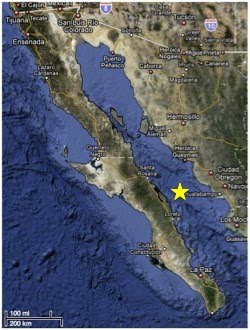After joining the next leg of the cruise, spearheaded by Andreas Teske from UNC- Chapel Hill (teskelab.wordpress.com), and waiting a long 10 days on board, Kristen and Meg had their dive in Alvin on December 2nd. With much anticipation, they headed down with the main goal of recovering the two thermocouple arrays that had been deployed at the end of our cruise. What would the newly formed vent deposits look like? Will they have grown through the titainium cages? Will the temperature loggers have functioned properly? We were very eager to see what we would find...
 Success!! A beautiful mushroom had grown through the array and it's stalk engulfed four of the eight thermocouples! When we checked the temperatures, one in the wall read 120˚C, and another 280˚C, and two that read 300˚C and 302˚C were indeed inside the vent fluid conduit (based on observations of the chimney wall recovered in the array- see photo below). We also sampled the white flange material in the middle portion of the mushroom above the stalk. We recovered the temperature logger and once back in the lab, downloaded the 15-day temperature records and subsampled the chimney for microbial analyses.
Success!! A beautiful mushroom had grown through the array and it's stalk engulfed four of the eight thermocouples! When we checked the temperatures, one in the wall read 120˚C, and another 280˚C, and two that read 300˚C and 302˚C were indeed inside the vent fluid conduit (based on observations of the chimney wall recovered in the array- see photo below). We also sampled the white flange material in the middle portion of the mushroom above the stalk. We recovered the temperature logger and once back in the lab, downloaded the 15-day temperature records and subsampled the chimney for microbial analyses. At the second array, a chimney had also grown in the titanium cage, much to our delight- since one had not grown during the previous 6-day deployment. Temperatures inside the chimney read 180˚C, 200˚C, and 260˚C. Again we recovered the logger, array and chimney. In addition, the gooey white and orange filamentous biofilm had formed over much of the chimney and array. Once back in the lab, we collected this gooey material for analysis, downloaded the temperature records, and subsampled the small chimney.
At the second array, a chimney had also grown in the titanium cage, much to our delight- since one had not grown during the previous 6-day deployment. Temperatures inside the chimney read 180˚C, 200˚C, and 260˚C. Again we recovered the logger, array and chimney. In addition, the gooey white and orange filamentous biofilm had formed over much of the chimney and array. Once back in the lab, we collected this gooey material for analysis, downloaded the temperature records, and subsampled the small chimney. We are very excited at these initial results and anxious to analyze the samples further in our labs back in the states. The Reysenbach group will use molecular biological tools to reveal the members of the microbial communities that developed in the 15-day old chimneys and compare the communities to those that developed during the shorter array deployments (see previous blog posts).
We are very excited at these initial results and anxious to analyze the samples further in our labs back in the states. The Reysenbach group will use molecular biological tools to reveal the members of the microbial communities that developed in the 15-day old chimneys and compare the communities to those that developed during the shorter array deployments (see previous blog posts).Our Recent Guaymas Impressions:
While we have certainly not been idly passing the days, being on board awaiting the recovery of our instruments 1.25 miles below us has afforded us opportunities to enjoy more of the amazing scenery and happenings around us. In particular, the sunsets have been gorgeous night after night. Below are four of our favorite shots of the sun slipping behind the hills of the Baja of California.
 On one afternoon that was forecast to be a little "stormy," beautiful rainclouds formed on the horizon and gave us glimpses of several rainbows throughout the day. During recovery, Alvin (with Anton on top) happened to float right in front of one!
On one afternoon that was forecast to be a little "stormy," beautiful rainclouds formed on the horizon and gave us glimpses of several rainbows throughout the day. During recovery, Alvin (with Anton on top) happened to float right in front of one! Legend has it that these moon rings are a sign of bad weather to come, but we preferred to think of it as a good portent for our impending recovery dive the following day. Given our successes and the calm seas that have followed, I think our interpretations were correct!
Legend has it that these moon rings are a sign of bad weather to come, but we preferred to think of it as a good portent for our impending recovery dive the following day. Given our successes and the calm seas that have followed, I think our interpretations were correct!We hope you have enjoyed following our Guaymas Expedition 2009 cruise blog! Meg and Kristen, on board for another few days, will soon leave behind the sunny Mexican days for the cold winters of Cape Cod and the Pacific Northwest- thank goodness for fireplaces... and chimneys!



